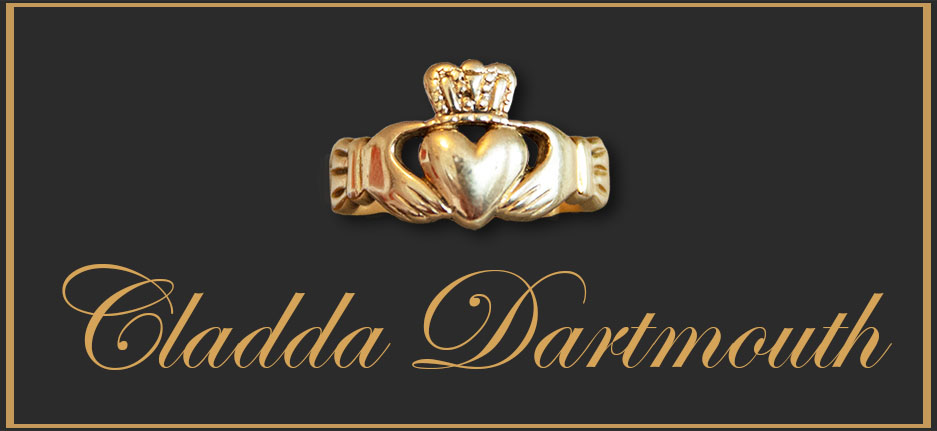The History of Cladda
Discover the history of Cladda and the famous Cladda Ring.
The History
The Claddagh Ring dates back well over three hundred years and belongs to a widespread group of finger rings called “Faith rings” or Fede in Italian which dates from Roman times. Fede rings were popular in the Middle Ages throughout Europe. They are distinguished by having the bezel cut or cast in the form of two clasped hands, symbolising faith, trust or “plighted troth”.
The beautiful emblem of the joined hands clasping a crowned heart was a traditional symbol of the inhabitants of the Claddagh village, an Irish village to the southwest of Galway city once said to be the oldest and most beautiful fishing village in Ireland. Unfortunately, the thatched cottages have been replaced and the traditional costume is no longer worn, but the symbol still exists.
In earlier times this design was the symbol of the “Fishing Kings of Claddagh” meaning ‘in love and friendship let us reign. In the 17th century, the symbol was first depicted on a ring which became the fashionable exchange of friends or lovers. Tradition has it, that the heart worn outwardly on the back of the finger signifies that the wearer is “heart-whole and fancy-free”. The ring was often an heirloom, passed from mother to daughter on the daughter’s wedding day.
The ascribed limits to where the ring came from are described roughly as the area from the Aran Islands on the West, and through all Connemara and Joyce Country to Galway, and then eastward and southward for about twelve miles in either direction. The whole district just happens to be the region surrounding Claddagh Village.
Some hundred years ago, there was another version of this ring in the city of Dublin named the Fenian Claddagh. This ring had two hands, two hearts, and no crown.
Symbolism:
The hands are there for friendship,
The heart is there for love.
For loyalty throughout the year,
The crown is raised above.
There are several forms of symbolism about the Claddagh ring, dependant on which hand it is worn.
Worn on the right hand with the heart turned outwards, the world will know that the heart has not yet been won.
Worn on the right hand with the heart turned inwards, it shows that friendship and love are being considered.
Worn on the left hand with the heart turned inwards, it means two loves have joined forever.
As mentioned above, the heart, hands, and crown have symbolism to the wearer, but from where does each symbol come? We have to start by going far back to the time of the Gods. Dagda, the father of the Gods was a powerful being, complete with the ability to make the sun standstill. This he did once and stretched a day and night into nine months, in which time he bedded with a goddess and she bore him a son. According to legend, Dagda represents the right hand of the ring.
In the time of the ancient Celts, Anu was the ancestral and universal mother of the Celtic people. She is also known as Danu to her people. She is said to represent the left hand of the ring.
The crown represents Beathauile.
Finally, the heart represents the hearts of each and every member of mankind, in addition to the element which gives everlasting music to the Gael.
Another interpretation of the meaning of the ring is based on and directly correlative to the Shamrock, one of the oldest symbols of the Holy Trinity among the Irish. This interpretation describes the crown as a symbol of the Father, the left hand as the Son, and the right hand as the Holy Ghost, all caring for the heart in the centre, symbolizing humanity.
Throughout each varying symbolism, a single theme shines through, specifically that the ring symbolises the trinity of “Love, Loyalty, and Friendship” or, in Gaelic, “Grá, Dílseacht agus Cairdeas” (pronounced ‘graw, deal shocked ogis cordiss’).
Folk Legends
The Origins of the Claddagh Ring even yet remains a matter for conjecture, most of the popular stories of its origins attribute it to the Joyce family of Galway City.
First off, there is a tale of one of the Kings of Claddagh who fell in love with a peasant girl. Because she was of the lower classes, his love fell unrequited. In the depths of depression, the king died, requesting that his grave bear the symbol of a pair of hands holding his crowned heart as a symbol for his undying love of the peasant girl.
As legend has it, the town developed the ring (originally a sigil to be painted on ships and sails) to be worn by sailors of Claddagh. When these sailors would run into other fishermen in their waters, they would check for the sigil, and if they did not find it, they would kill them.
Another story says that Margaret Joyce married Domingo de Rona, a wealthy Spanish merchant who traded with Galway. They proceeded to Spain, where he died, leaving her a considerable fortune. Returning to Galway she used her fortune to build bridges from Galway to Sligo, and re-married Oliver Og French, Major of Galway 1596/7. She was rewarded for her good works and charity by an eagle who dropped the original Claddagh ring into her lap.
A more likely story says that a Richard Joyce of Galway was captured by Algerian corsairs while on his way to the West Indies plantations, sold to a Moorish goldsmith who trained him in the craft. In 1689 he was released from slavery as a result of a demand from King William III. The Moor offered him his only daughter in marriage and half his wealth if he would remain in Algiers, but Joyce declined and returned home, taking with him the idea of the Claddagh ring.
